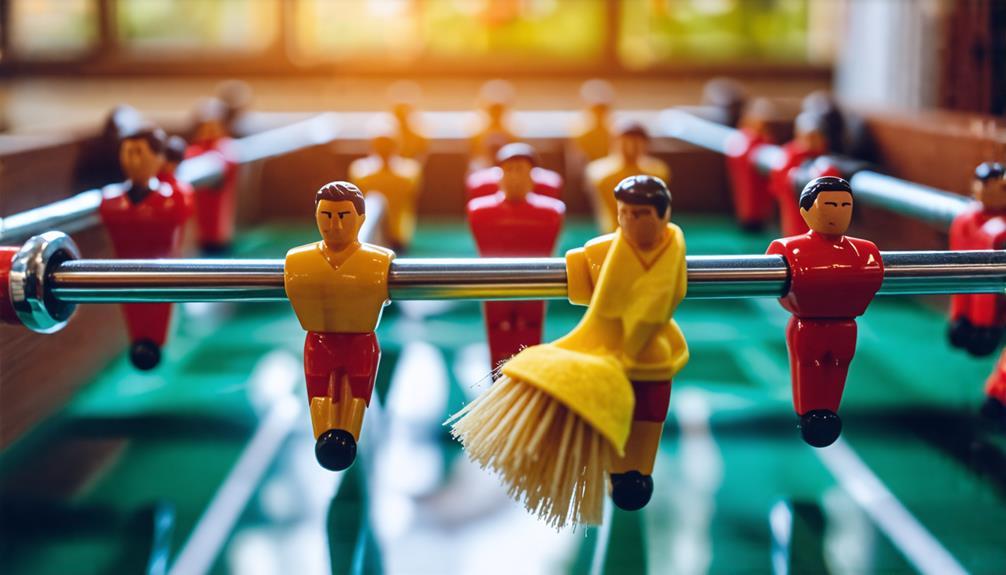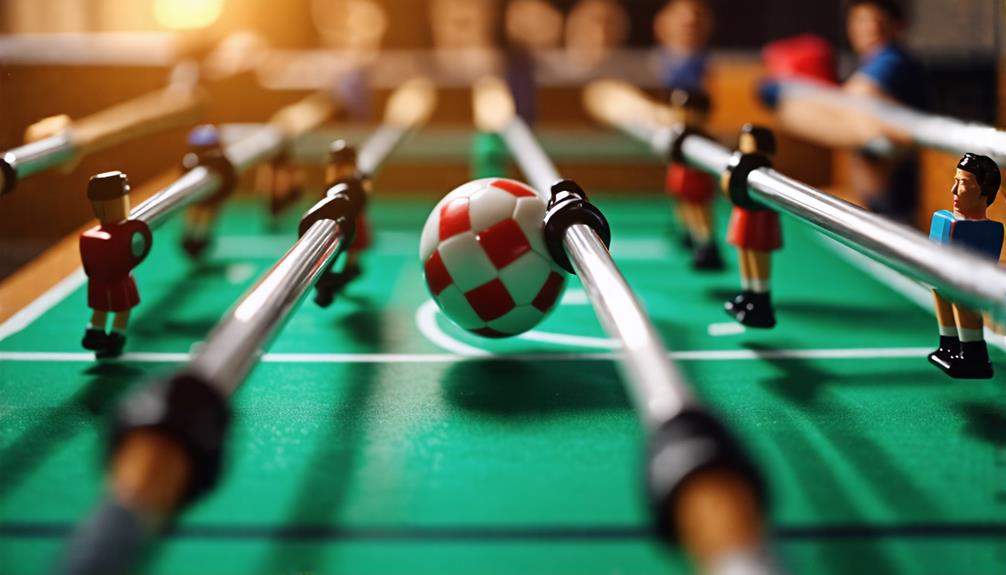The Ultimate Guide to Buying a Foosball Table
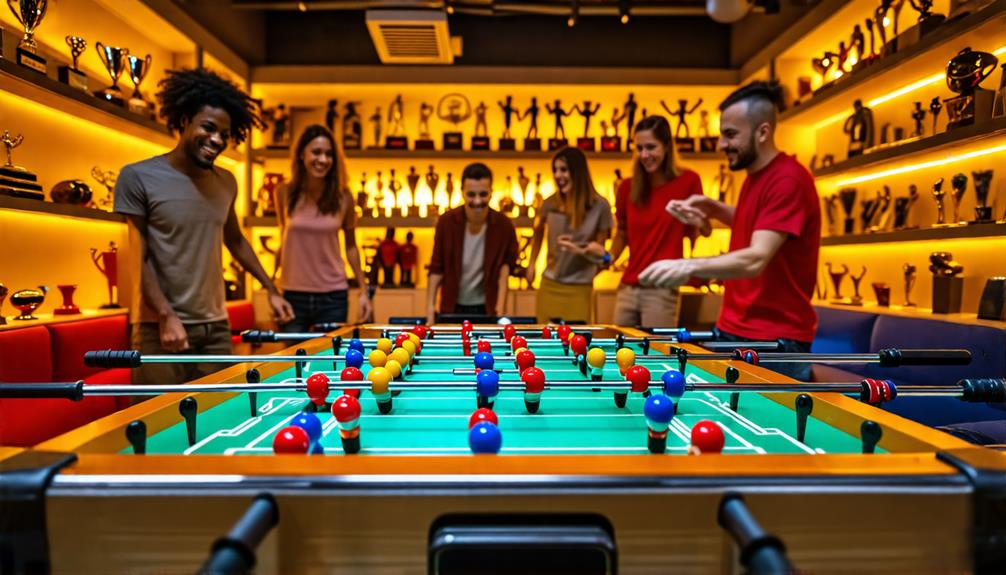
When considering a foosball table, it's essential to understand not just the fun it brings, but also the nuances that make a table worth your investment. Key factors include construction quality, size, and features that enhance your gameplay experience. With numerous options available, it can be overwhelming, but knowing what truly matters can simplify your decision. Before making a purchase, let's delve into the critical elements that will help you choose the right table for your needs.
History of Foosball
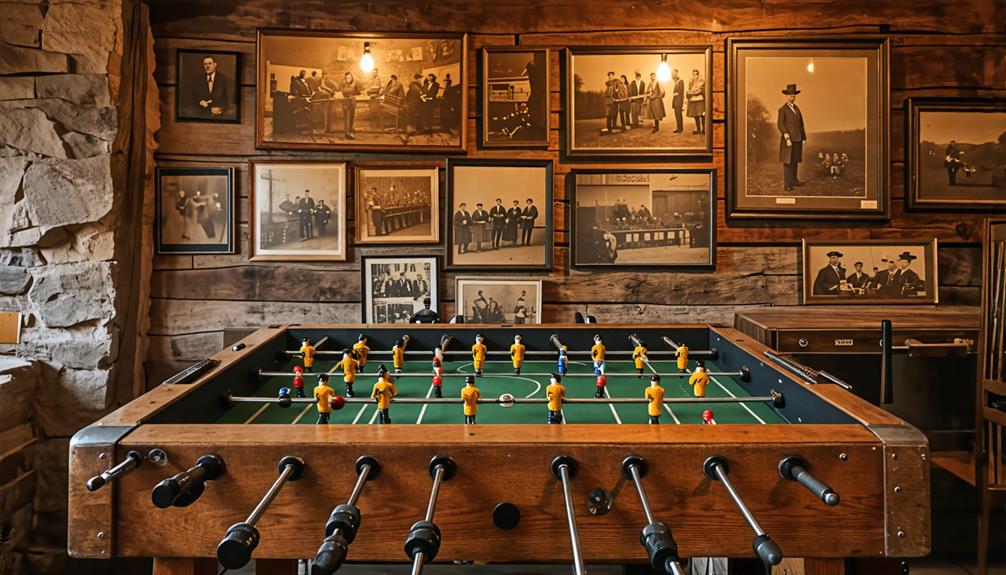
Foosball, originally conceived as an indoor version of football, traces its roots back to late 19th century Europe. The game's first patent was filed by Harold Searles Thornton in the 1880s, marking its initial rise as a popular parlor game. Its popularity quickly spread across Europe, particularly in France and Germany, before reaching the United States post-World War II, brought over by European immigrants.
Foosball evolved from a simple pastime into a competitive sport over the decades. A significant milestone in its history was the first official foosball tournament held in the United States in 1962. The game's fast-paced nature and minimal equipment requirements make it accessible and engaging for players of all skill levels and ages. Social interaction is a key aspect of foosball, fostering friendly competition and teamwork. The game also demands strategic thinking and quick reflexes, ensuring that each match is an exhilarating experience that keeps players coming back for more.
Types of Foosball Tables
Understanding the history of foosball helps you appreciate the variety of tables available today, each designed to cater to different preferences and play styles. Standard foosball tables are full-size, heavy-duty models made from solid wood or high-quality particle board, ideal for home use.
Coin-operated foosball tables are built to withstand heavy traffic in public venues and require coins to play, offering durability and a steady revenue stream. For those with limited space or budget, combination game tables offer versatility and space-saving benefits by allowing you to switch between foosball, air hockey, and billiards.
If portability is a priority, tabletop foosball tables are compact and easily stored, making them perfect for casual play in small areas or with young children. Outdoor foosball tables are made with weather-resistant materials, ensuring they can endure the elements and provide quality entertainment in your backyard or patio. Each type of foosball table offers unique benefits, so consider your specific needs and circumstances before making a decision.
Key Features to Consider
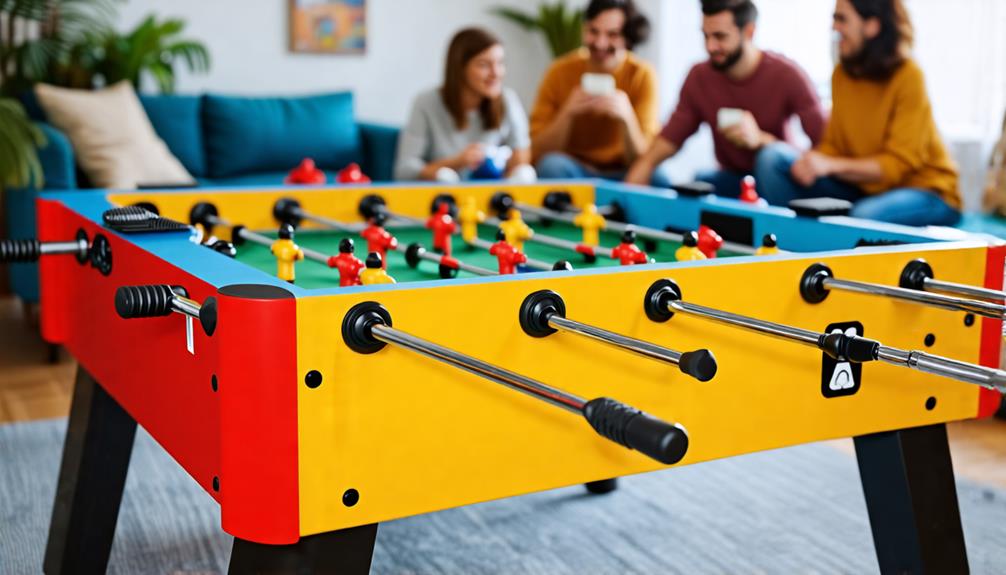
When choosing a foosball table, focus on key features that enhance gameplay and durability to ensure you get the best value for your investment. Start with construction quality; tables made of solid wood offer superior durability compared to those made from particle board, making them a worthwhile investment.
Next, consider the rod types. Hollow steel rods facilitate faster gameplay and agility, while solid rods provide better control and durability, significantly impacting your overall experience. Additionally, look for tables with counterweighted foosball men. These ensure a consistent horizontal position, which enhances shot accuracy and control during play. Built-in levelers are another crucial feature. They maintain a fair playing surface, preventing ball bias in competitive settings.
Size and Space Requirements
Choosing the right size foosball table is essential to ensure enough space for comfortable gameplay and movement. The standard dimensions of a regulation-size table are 56 inches long, 30 inches wide, and 36 inches high. When planning your available space, account for a minimum clearance of 3-4 feet around the table, especially on the long sides. This clearance ensures optimal gameplay and allows players to move freely without obstruction.
If space is limited, consider compact tables designed for smaller areas. These tables maintain playability while fitting into restricted spaces, making them ideal for apartments or game rooms. However, for competitive play, a regulation-size table that complies with ITSF specifications is essential. Before purchasing, measure your space accurately to ensure it can comfortably accommodate the table size and necessary clearance. Balancing table size and available space will help create an enjoyable foosball experience without compromising gameplay quality.
Budgeting for a Foosball Table
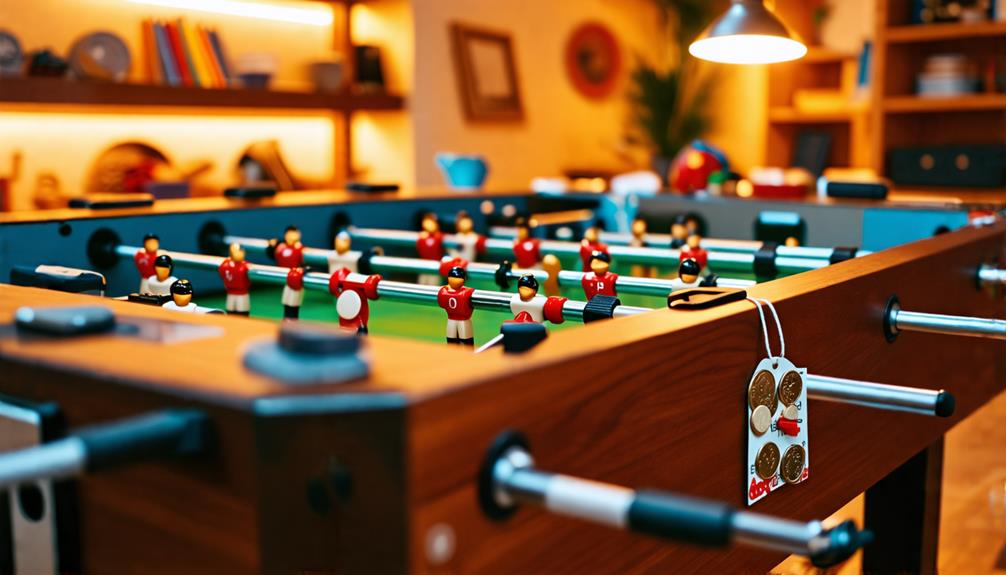
Budgeting for a foosball table requires careful consideration of your priorities and financial constraints. Quality foosball tables vary widely in price, starting around $100 for basic models and reaching up to $4,000 for premium options. For beginners, tables priced between $300 and $800 offer a solid introduction. As your skills improve, mid-range tables, typically priced between $800 and $1,500, provide a good balance of quality and features.
For those seeking a personalized experience, custom-built tables range from $950 to over $14,000. Additionally, don't forget to account for supplementary costs such as accessories, maintenance, and delivery fees. By defining your budget and understanding the various price ranges, you can make an informed decision that aligns with your financial situation and meets your needs.
Where to Purchase a Foosball Table
Where can you find the best foosball tables for your needs? When you decide to purchase a foosball table, you have several options. Online marketplaces like Amazon offer a wide range of foosball tables, allowing you to compare prices and read product descriptions from different sellers.
If you prefer a hands-on approach, visit local sporting goods stores. They often have a selection of tables on display, enabling you to inspect the quality and dimensions before buying. Major manufacturers such as Tornado, KICK, and Garlando also sell directly through their websites, providing customization options and warranty information.
For budget-conscious buyers, consider exploring second-hand options on platforms like Craigslist or Facebook Marketplace. Just make sure to verify the condition of the table before committing to the purchase. Regardless of where you shop, always check online reviews to find reputable sellers and brands. This will help ensure you have a satisfactory buying experience and that your foosball table meets your expectations. With these options in mind, you're well on your way to finding the perfect foosball table for your home or game room!
Accessories and Maintenance
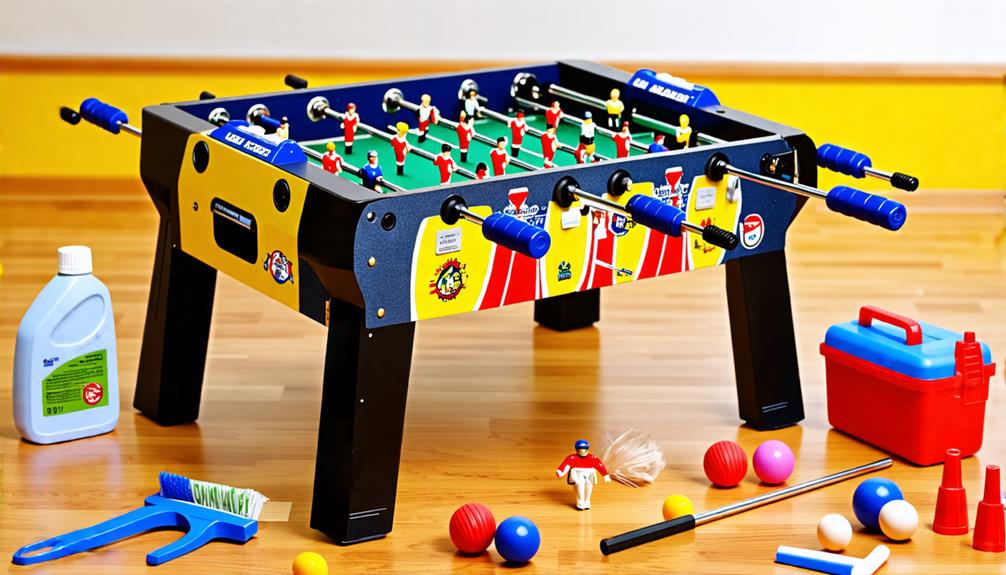
Investing in a foosball table involves more than just the initial purchase; accessories and maintenance are crucial for long-term enjoyment. Equip yourself with high-quality balls, protective covers, and a maintenance kit to keep your table in optimal condition. Additionally, understanding how to troubleshoot common issues will ensure smooth gameplay for years to come.
Essential Accessories Overview
To enhance your foosball experience, essential accessories and proper maintenance are crucial for both enjoyment and the longevity of your table. Here's a concise overview of key accessories to consider:
- High-quality balls: Opt for durable balls made from various materials and sizes to ensure optimal gameplay.
- Table covers: Use covers to protect your table from dust, moisture, and scratches, significantly extending its lifespan.
- Maintenance kits: These kits typically include rod lubricants, cleaning cloths, and tools for tightening screws and adjusting table levelers, essential for keeping your table in top condition.
- Cleaning supplies: Employ mild soap and water to clean the table surface, protecting it from damage and deterioration.
Investing in these accessories not only enhances your foosball experience but also ensures smooth gameplay. Regular cleaning and lubrication of rods prevent buildup and keep your table performing at its best. With proper dust protection and maintenance, your foosball table will remain a source of entertainment for years to come.
Maintenance Best Practices
Proper maintenance of your foosball table not only enhances gameplay but also extends its lifespan. Begin by cleaning the playing surface and rods regularly with a soft cloth and suitable cleaning agents to prevent buildup that can impair performance. Lubricate the rods with a silicone-based lubricant every few months to ensure smooth movement and reduce friction. Always use a protective cover when the table isn't in use, especially for outdoor models, to shield it from dust, moisture, and potential weather damage.
Additionally, inspecting and tightening all screws and bolts periodically is crucial for maintaining stability and preventing unwanted wobbling during gameplay. In humid climates, it's advisable to store the table indoors when not in use to protect the wooden components and preserve material integrity.
Troubleshooting Common Issues
Resolving common foosball table problems often involves straightforward maintenance and checks. Here are some essential steps:
- Level the Table: Ensure your table is even using built-in leg levelers. An uneven surface can cause biased ball movement, affecting gameplay quality.
- Inspect the Playing Surface: Examine the surface for scratches or dents. A smooth surface is crucial for optimal ball movement, so address any imperfections promptly.
- Lubricate the Rods: Regularly clean and lubricate the rods to prevent rust and ensure smooth motion. If the rods become stuck, check for debris in the bearings and apply lubricant as needed.
- Use High-Quality Accessories: Invest in quality foosballs and maintenance kits to enhance gameplay and extend your table's lifespan. High-quality accessories can help prevent issues related to wear and tear.
Troubleshooting Common Issues
Troubleshooting common issues with your foosball table can significantly enhance your gameplay experience. Start by checking the rods; if they're sticking or hard to move, ensure they're lubricated and free of debris in the bearings. Poor ball control often stems from the quality of the playing surface, so opt for laminated surfaces that allow for smoother play compared to cheaper stick-on options. If the ball consistently gets stuck, inspect the playing surface for unevenness. Use the table levelers to adjust it, confirming that every part of the table is even.
A significant wobble or instability during play suggests that the legs may not be securely attached or properly leveled. Double-check these adjustments for optimal stability. Additionally, if your foosball men aren't returning to their original position after spinning, verify that counterbalance weights are present on each player. Missing weights can severely hinder gameplay, affecting both performance and enjoyment.
Conclusion
To sum up, purchasing a foosball table can be an exhilarating adventure when you know what to look for. By considering the history, types, key features, and your budget, you'll make an informed choice that enhances your gameplay. Don't forget to research where to buy and maintain your table properly to keep it in top shape. With the right knowledge, you're set to enjoy countless hours of fun and competition with family and friends. Happy foosballing!
